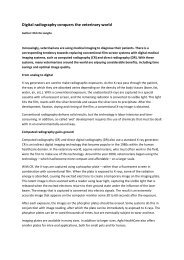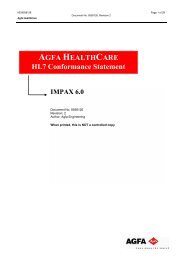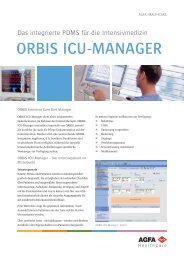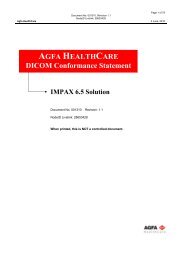envision your eHr withimaging using iciSDespite the promise of the ElectronicHealth Record (EHR) to provide a view ofpatient health generated from encountersacross all healthcare settings, imaginghas been a critical missing component.Until now. In keeping with its “Leave noimage behind” promise, <strong>Agfa</strong> <strong>HealthCare</strong>has developed the Imaging ClinicalInformation System, or ICIS, to provideclinical images within the EHR. In thisarticle, Charles Morris, Chris Magyarand Genady Knizhnik of <strong>Agfa</strong> <strong>HealthCare</strong>reveal how ICIS empowers physicians tomake more informed care decisions byembedding medical image accessibilitywithin the EHR user interface to provide amore accurate view of the patient.ICISEXCHANGEICISACCESSICISCONNECTICISWORKFLOWICISVIEWICISCAPTUREICISVNAgiven these realities, image-enabling theEHR is a logical way to help physiciansdeliver higher quality care, faster. To putit in context, imagine an orthopaedicor plastic surgeon is preparing to repaira patient’s severely injured hand. Ifthe surgeon was able to access imageswithin the EHR to visualize the hand,using clinical photography side by sidewith CT and perhaps even MRI imaging,it would add so much value to theprocess and the patient. Furthermore,if the primary care physician also hadeasy access to pre- and post-surgeryimages and reports through the EHR,that patient’s experience would becomericher still.Healthcare organizations around theglobe are under pressure to delivercare more cost-effectively and withhigher quality. One way to achievethis is to empower physicians witheasy, direct access to all of a patient’srelevant medical information. While thisunderstanding is driving a meteoric risein Electronic Health Record installations,there is still one significant roadblock toultimate clinical productivity: most ofthe EHRs available on the market todaydo not complement the textual data withrelevant clinical images.“Physicians can deliver better, moreexpedient care when they haveimmediate access to a patient’s entiremedical history regardless of the caresetting the information was createdwithin,” explains Charles Morris,ICIS US Market Segment Manager.“If they are limited to only looking atthe textual data that comes out of theEHR, then they aren’t getting the wholepicture. The addition of pre-diagnostic,diagnostic, treatment, and descriptiveimaging data gives a truly integratedview of the continuity of care.”imAging silos ARE widEspREAdgiving physicians access to all theimages associated with a particularpatient isn’t easy. “Most departmentshave their own solutions for capturingimages, but their strategies for storingand distributing those images varygreatly,” says genady Knizhnik, Business16 THEREDevelopment Director, Regional HealthEMEA. “Radiology has the systems inplace to manage all of their images, dataand workflow – and even to collaboratethrough regional PACS – but otherdepartments do not have the same levelof sophistication. Solutions can rangefrom sophisticated and automated imagecapture and workflow to simple digitalsnapshots, for example, in dermatology.”While each department’s clinical imagestorage solution is based on proceduresthat work fine within their own walls,things get more complicated when theytry to share those images with colleaguesin other facilities or departments, orwith referring physicians.“Images are going into privatedepartmental silos in every possibleway that you can imagine,” explainsChris Magyar, Head of the ICIS BusinessUnit for the US Region. “Some imagesare printed out and filed in a paperrecord. Some are stored on hard drives,CD or USB sticks. Some are enteredas a line item in a spreadsheet. Nowimagine you’re a physician from anotherdepartment and you’re making a caredecision. How much time do you haveto hunt that image down? Even if you dohave the time, there is no guarantee thatyou will find what you are looking forin the end. You have to choose betweendoing without that piece of the puzzleor, if you can’t, reordering an imagingstudy that has already been performed.”TAking THE EHR To A wHolE nEwlEvEl“Our Imaging Clinical InformationSystem addresses a whole class ofmissing information from the EHR,”explains Morris. “It seamlessly capturesimaging data in a clinical contextand then links it to the EHR. Sincethe images are embedded inside theprimary textual interface, it is muchmore streamlined and efficient for thepeople using it. Images are presented inthe context of the patient’s entire healthrecord. Doctors do not know that ICISis managing the imaging health record,they simply know that images show upwithin the EHR when they need them.”According to Morris, creating ICISinvolved looking at existing <strong>Agfa</strong><strong>HealthCare</strong> solutions and expertiseand imagining what was possible.“iciS has workflow componentsfor capturing image sourcesthat do not adhere to DicoMstandards, creating metadataaround them and deliveringthem to the same vendorneutral archive as the moretraditional imaging generated bydepartments like radiology.”gENADY KNIZHNIK, Business DevelopmentDirector, Regional Health EMEA
“The addition of pre-diagnostic,diagnostic, treatment, anddescriptive imaging data givesa truly integrated view of thecontinuity of care.”Charles Morris,ICIS US Market Segment Manager“We wanted to create a platformsolution composed of <strong>Agfa</strong> <strong>HealthCare</strong>technologies that were pre-integratedtogether in a particular way so thatwhen we encounter a department thathas gaps along the chain of acquiring,viewing, interpreting, storing andsharing images, we can offer them acomplete workflow. And that workflowleverages technology that is in placeor provides supplemental technologyto produce a high-quality, intelligentimaging study that is ready for EHRintegration.”“ICIS has workflow components forcapturing image sources that do notadhere to DICOM standards, creatingmetadata around them and deliveringthem to the same Vendor NeutralArchive as the more traditionalimaging generated by departments likeradiology,” explains Knizhnik. “So if wego back to our surgery example, wherethe emergency department is recordingimages with their digital camera,ICIS can store those images alongsidetraditional DICOM images and makeboth accessible to everyone through theEHR.”ICIS also includes <strong>Agfa</strong> <strong>HealthCare</strong>’swidely adopted regional health portfoliothat enables the creation of imagesharing networks across administrativeor geographical boundaries. Thisprovides radiologists and clinicians withaccess to the patient’s entire radiologyhistory irrespective of the originatingradiology department. Moreover, itenables health authorities to optimizethe utilization of both radiologistand radiology equipment by allowingan “acquire anywhere – report fromanywhere” workflow.ICIS has the clinical breadth to crossthe 3 primary care settings: inpatient,ambulatory/outpatient and physician’soffices. Since each environment deliverscare differently (encounter-basedmedicine vs. schedule-based medicinevs. office appointments), ICIS supportstheir unique workflow in order tosuccessfully acquire images.ICIS is for everyone“In a way, ICIS is really the secondfrontier of the EHR,” says Morris. “Theprimary health record is the singlemost important thing we can do forpatients. And then right behind it is theimaging record. All hospitals need thistechnology.”ICIS offers a vendor neutral architectureand support for multiple patient IDdomains. What this enables is the abilityto provide a comprehensive patienthealth record across departments withina single facility or between multiplefacilities. Hospital groups, IntegratedDelivery Networks (IDN), or public andprivate health information exchangescan develop and effectively share unifiedpatient records containing both imagesand textual information.“ICIS enables healthcare organizationsto share imaging information acrossregional, facility, departmental andtechnical boundaries,” says Magyar.“This allows them to focus on theirprimary mission of care delivery.”In this era of increasing regulatorypressures and efficiency focus, gettingimages out of departmental silos and infront of the physicians who need themjust makes sense. Adding an imaginglayer to the EHR with ICIS can deliverfar-reaching benefits that go above andbeyond expedited delivery of care andimproved clinical confidence. Surgeonscan use it to enhance their preparationprocess. Primary care physicians canleverage it to deliver more detailed,image-rich patient consultations.Physicians can access it to streamlinetheir collaborations, even in emergencymedical situations. Plus having theimages in the EHR where authorizedstakeholders can access them helpseliminate the cost- and labor-intensiveprocess of ordering duplicate imagingprocedures.“You don’t need to wait until your EHRis up and running to think about imageenablement,” advises Knizhnik. “Ifyou’re in the process of implementingyour EHR, or even if you’re just in theplanning stages, it is a good time tohave a conversation about ICIS. Getting<strong>Agfa</strong> <strong>HealthCare</strong> involved earlier in theprocess is beneficial because we can helpmake important decisions regardingthe acquisition, discovery and access ofimaging and non-imaging data.”Industry-first image enablementICIS is a unique solution in the industrytoday. “The healthcare market is nowfully appreciating the value of managingimages in the EHR,” says Knizhnik.“<strong>Agfa</strong> <strong>HealthCare</strong> is in a great positionto leverage the experience we havegained over the past 15 years improvingimage and information managementfor the radiology world. We have theexperience, expertise and products tomake it happen.”“We don’t just think about imagemanagement from the perspective ofthe radiologist,” says Magyar. “We havebeen stretching beyond that perspectivefor some time and considering howimaging affects the overall quality, costand effectiveness of care. Any number ofvendors will sell you a place to store yourimages. That’s not good enough. Thetrue value comes in having a solutionthat gives physicians access to storedimages from all sources in the contextof the EHR. That’s what makes ICISdifferent and so powerful.”“Someone might ask why physiciansneed images in the EHR now when theircurrent methods have served them forso long. Diagnoses still happen, peoplereceive the care that they need,” saysMorris. “It is one of those you-don’tknow-what-you’ve-been-missing-untilyou-have-itscenarios. Once physicianshave access to the image-enabled EHR,just try taking it away. They won’t letyou.” <strong>Agfa</strong> <strong>HealthCare</strong> has alreadyenabled sharing of imaging data forcustomers in Europe, Brazil, Canada,and the United States. ICIS is globallyavailable to healthcare organizationseverywhere.“ICIS enables healthcareorganizations to share imaginginformation across regional,facility, departmental andtechnical boundaries. Thisallows them to focus ontheir primary mission of caredelivery.”Chris Magyar,Head of the ICIS Business Unit for the US RegionTHERE 17
















